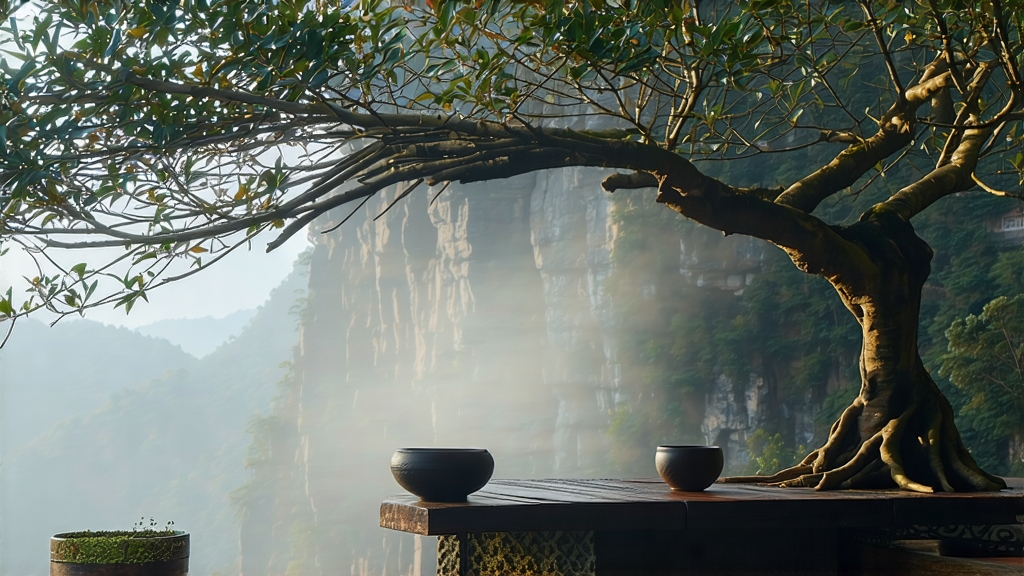
High above the East China Sea, where Guangdong Province’s coastline bends toward the South China Sea, the granite spine of Fenghuang (Phoenix) Mountain rises through three climatic zones in fewer than fifteen kilometres. Between 350 m and 1 400 m, temperatures swing 12 °C in a single day, fog drifts through evergreen forests, and the soil is so porous that a noon shower has vanished by dusk. In this aerie the Song-era ancestors of the She and Hakka peoples discovered wild tea trees whose leaves, when half-oxidised, released fragrances that seemed to quote every flower and fruit growing within sight. Over eight centuries those trees became Phoenix Dancong—“single grove”—an oolong family so perfumed that Chinese connoisseurs rank it alongside Burgundy crus for aromatic complexity.
History: From Imperial Tribute to Boutique Icon
The first written record appears in 1278, when imperial inspectors noted “nectar aroma tea” sent from Fenghuang to the Yuan court. During the Ming, local magistrates designated 900 ancient trees as gongcha (tribute tea); each spring soldiers guarded the mountain while pickers climbed rope ladders to harvest the tallest groves. After the 1911 revolution the tribute system collapsed, but the trees survived thanks to village lineages who recorded mother-tree names, pollen-parentage and micro-locations in clan genealogies. When China opened in the 1980s, overseas Chaozhou merchants revived demand; today a single 300-year-old “Song Zhong” tree can earn its village more than a luxury sedan, and auction lots of “Mi Lan Xiang” (honey-orchid fragrance) fetch prices rivalling top Da Hong Pao.
Botany and “Fragrance Types”: Nature’s Aromatic Library
Unlike the clonal plantations that blanket most tea regions, Phoenix Dancong is propagated by seed, creating a living library of flavours. Growers classify each distinctive profile as a “xiang” (fragrance type); the official register lists 79, but mountain villagers speak of over 200. The most celebrated include:
• Mi Lan Xiang – honey-orchid, warm and velvety
• Huang Zhi Xiang – gardenia, bright and citrus-edged
• Zhi Lan Xiang – orchid-lily, cool and expansive
• Xin Ren Xiang – toasted almond, marzipan sweetness
• Jiang Hua Xiang – ginger flower, peppery finish
Each type is tied to a mother tree, often named after its discoverer, cliff shape or folklore event. Cuttings are never taken more than two generations away, preserving what locals call “mountain memory”.
Craft: The Dance of Sun, Wind and Charcoal
Phoenix Dancong is harvested in late April, when two leaves and a bud still curl like a sparrow’s tongue. The work begins at dawn; by 10 a.m. the baskets must reach the village square where the four classical oolong stages unfold in rhythmic succession:
- Wilting: Leaves are spread on bamboo racks inside a shaded corridor where mountain breezes lower moisture to 68 %. The goal is suppleness, not desiccation—too much sun and the mountain aroma evaporates.
- Shaking: Every hour the tea master tosses the leaves into a rattan drum, tumbling them for exactly 18 revolutions. Micro-tears along the leaf edge oxidise at different speeds, building layered fragrance. The pause between shakes is judged by the scent rising from the pile: when gardenia turns to ripe peach, the next shake begins.
- Fixing: A 280 °C wok arrests oxidation at 45–50 %, the sweet spot where green chlorophyll yields to amber while preserving floral volatiles. The master’s bare hand sweeps across the iron surface; calloused skin is more reliable than any thermometer.
- Rolling & Shaping: The hot leaves are wrapped in linen and rolled on a rattan mat until they twist into dark green commas. This bruises inner cells so that oils migrate outward, ready to bloom in the cup.
- Baking: The most mythic stage. Using only lychee-wood charcoal, the tea is baked for 7–10 hours in a squat clay oven whose temperature curve resembles a cardiogram: 90 °C falling to 50 °C, then back to 80 °C. Between cycles the leaves rest 24 hours, allowing residual moisture to migrate outward. A second lighter bake months later “marries” the aromas, yielding the signature honeyed finish that lingers on the